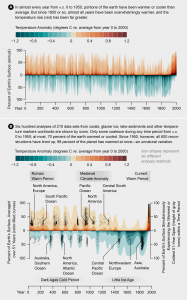Global Warming Is Not Part of Natural Climate Variability – Scientific American, November 2019
Text by Mark Fischetti & Graphics by Pitch Interactive, Scientific American, page 86, November 2019
People who dismiss climate change often claim that the earth’s warm-up is simply part of “natural climate variability.” A paper published in July in Nature puts that argument to rest.
The authors show that warm and cold years were regularly interspersed during the past 2,000 years (A graph below) and that even the warmest and coldest periods were experienced only by isolated regions at a given time—never across the entire globe simultaneously (B graph below).
But the current warm-up has taken place across 98 percent of the globe at the same time, from about 1900 through today. “It’s completely different,” states lead researcher Raphael Neukom of the University of Bern in Switzerland. All regions have heated up relentlessly, in unison.
#########################################
Consistent multidecadal variability in global temperature reconstructions and simulations over the Common Era
Nature (Geoscience) Article by Raphael Neukom, Luis A. Barboza, Michael P. Erb, Feng Shi, Julien Emile-Geay, Michael N. Evans, Jörg Franke, Darrell S. Kaufman, Lucie Lücke, Kira Rehfeld, Andrew Schurer, Feng Zhu, Stefan Brönnimann, Gregory J. Hakim, Benjamin J. Henley, Fredrik Charpentier Ljungqvist, Nicholas McKay, Veronika Valler & Lucien von Gunten, 24 July 2019
REFERENCE: Nature Geoscience 12, 643–649(2019), July 24, 2019
ABSTRACT — Multidecadal surface temperature changes may be forced by natural as well as anthropogenic factors, or arise unforced from the climate system.
Distinguishing these factors is essential for estimating sensitivity to multiple climatic forcings and the amplitude of the unforced variability.
Here we present 2,000-year-long global mean temperature reconstructions using seven different statistical methods that draw from a global collection of temperature-sensitive palaeoclimate records.
Our reconstructions display synchronous multidecadal temperature fluctuations that are coherent with one another and with fully forced millennial model simulations from the Coupled Model Intercomparison Project Phase 5 across the Common Era.
A substantial portion of pre-industrial (1300–1800 ce) variability at multidecadal timescales is attributed to volcanic aerosol forcing.
Reconstructions and simulations qualitatively agree on the amplitude of the unforced global mean multidecadal temperature variability, thereby increasing confidence in future projections of climate change on these timescales.
The largest warming trends at timescales of 20 years and longer occur during the second half of the twentieth century, highlighting the unusual character of the warming in recent decades.
[NOTE: Please click on the graphics above to enlarge.]


{ 1 comment… read it below or add one }
Global Warming Is Not Part of Natural Climate Variability – Scientific American, November 2019, page 86.
Author Information with Affiliations —
Oeschger Centre for Climate Change Research and Institute of Geography, University of Bern, Bern, Switzerland: Raphael Neukom, Jörg Franke, Stefan Brönnimann & Veronika Valler — Escuela de Matematica-CIMPA, Universidad de Costa Rica, San Jose, Costa Rica: Luis A. Barboza — School of Earth and Sustainability, Northern Arizona University, Flagstaff, AZ, USA: Michael P. Erb, Darrell S. Kaufman & Nicholas McKay — Key Laboratory of Cenozoic Geology and Environment, Institute of Geology and Geophysics, Chinese Academy of Sciences, Beijing, China: Feng Shi — Department of Earth Sciences, University of Southern California, Los Angeles, CA, USA: Julien Emile-Geay & Feng Zhu — Department of Geology and ESSIC, University of Maryland, College Park, MD, USA: Michael N. Evans — School of Geosciences, University of Edinburgh, Edinburgh, UK: Lucie Lücke & Andrew Schurer — British Antarctic Survey, Cambridge, UK: Kira Rehfeld — Institute of Environmental Physics, Ruprecht-Karls-Universität Heidelberg, Heidelberg, Germany: Kira Rehfeld — Department of Atmospheric Sciences, University of Washington, Seattle, WA, USA: Gregory J. Hakim — School of Earth Sciences, University of Melbourne, Melbourne, Victoria, Australia: Benjamin J. Henley — Bolin Centre for Climate Research, Stockholm University, Stockholm, Sweden: Fredrik Charpentier Ljungqvist — PAGES International Project Office, Bern, Switzerland: Lucien von Gunten.